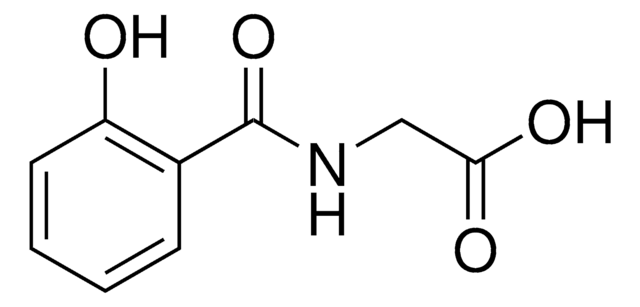推薦產品
品質等級
化驗
≥95% (NMR)
形狀
solid
顏色
white to pale yellow
儲存溫度
2-8°C
SMILES 字串
OC(=O)CNC(=O)C1=CC=CC(O)=C1
InChI
1S/C9H9NO4/c11-7-3-1-2-6(4-7)9(14)10-5-8(12)13/h1-4,11H,5H2,(H,10,14)(H,12,13)
InChI 密鑰
XDOFWFNMYJRHEW-UHFFFAOYSA-N
一般說明
3-Hydroxyhippuric acid is an acyl glycine. Acyl glycines are normally minor metabolites of fatty acids. However, the excretion of certain acyl glycines is increased in several inborn errors of metabolism. In certain cases the measurement of these metabolites in body fluids can be used to diagnose disorders associated with mitochondrial fatty acid beta-oxidation. Acyl glycines are produced through the action of glycine N-acyltransferase (EC 2.3.1.13) which is an enzyme that catalyzes the chemical reaction: acyl-CoA + glycine < -- > CoA + N-acylglycine. 3-Hydroxyhippuric acid is an organic acid found in normal human urine. 3-Hydroxyhippuric acid is a metabolite of rutin detected in urine after consumption of tomato juice (a source of rutin). 3-Hydroxyhippuric acid has its origin in dietary procyanidins (a major source of polyphenols consisting of elementary flavan-3-ol (epi)catechin units). 3-Hydroxyhippuric acid is a microbial aromatic acid metabolite derived from dietary polyphenols and flavonoids, found in normal human urine. It is a marker of gut Clostridium species. Higher levels are associated with higher levels of Clostridia.
應用
3-Hydroxyhippuric acid is a versatile molecule and it finds application in microbiome, biochemical and metabolomics research.
特點和優勢
- Can be used in Metabolomics and Biochemical research
- High-quality compound suitable for multiple research applications
其他說明
For additional information on our range of Biochemicals, please complete this form.
儲存類別代碼
11 - Combustible Solids
水污染物質分類(WGK)
WGK 3
閃點(°F)
Not applicable
閃點(°C)
Not applicable
Choose from one of the most recent versions:
分析證明 (COA)
Lot/Batch Number
Don't see the Right Version?
If you require a particular version, you can look up a specific certificate by the Lot or Batch number.
Xiyue Xiong et al.
BioMed research international, 2016, 9485412-9485412 (2016-04-29)
Autism spectrum disorders (ASDs) are a group of mental illnesses highly correlated with gut microbiota. Recent studies have shown that some abnormal aromatic metabolites in autism patients are presumably derived from overgrown Clostridium species in gut, which may be used
Marie-Paule Gonthier et al.
Journal of chromatography. B, Analytical technologies in the biomedical and life sciences, 789(2), 247-255 (2003-05-14)
An HPLC-ESI-MS-MS method was developed to quantify in human urine fourteen aromatic acids known as metabolites of dietary polyphenols. These metabolites were determined simultaneously in a single 20-min chromatographic analysis with multiple reaction monitoring detection. The inter- and intra-day precisions
Marie-Paule Gonthier et al.
Free radical biology & medicine, 35(8), 837-844 (2003-10-15)
Procyanidins are major dietary polyphenols made of elementary flavan-3-ol (epi)catechin units. They have antioxidant properties and may contribute to health benefits in humans, but little is known about their metabolic fate. We compared here the metabolism of procyanidin dimer B3
Andreas R Rechner et al.
Free radical research, 36(11), 1229-1241 (2003-02-21)
Berry extracts rich in anthocyanins have been linked to protective effects including the modulation of age-related neurological dysfunction and the improvement of the resistance of red blood cells against oxidative stress in vitro. In this study the bioavailability, metabolism and
Indu B Jaganath et al.
Free radical research, 40(10), 1035-1046 (2006-10-04)
Tomato juice containing rutin (quercetin-3-rutinoside) was ingested by healthy volunteers and ileostomists. Blood and urine collected over 24 h were analysed by HPLC with photodiode array (PDA) and tandem mass spectrometric detection. Low concentrations of isorhamnetin-3-glucuronide (Cmax = 4.3 +/-
我們的科學家團隊在所有研究領域都有豐富的經驗,包括生命科學、材料科學、化學合成、色譜、分析等.
聯絡技術服務







